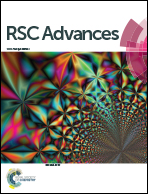Fluorescent probe based on N-doped carbon dots for the detection of intracellular pH and glutathione†
Abstract
Carbon dots (CDs) as fluorescent probes have been widely exploited to detect biomarkers, however, tedious surface modification of CDs is generally required to achieve a relatively good detection ability. Here, we synthesized N-doped carbon dots (N-CDs) from triethylenetetramine (TETA) and m-phenylenediamine (m-PD) using a one-step hydrothermal method. When the pH increases from 3 to 11, the fluorescence intensity of the N-CDs gradually decreases. Furthermore, it displays a linear response to the physiological pH range of 5–8. Au3+ is reduced by amino groups on the surface of N-CDs to generate gold nanoparticles (AuNPs), causing fluorescence quenching of the N-CDs. If glutathione (GSH) is then added, the fluorescence of the N-CDs is recovered. The fluorescence intensity of the N-CDs is linearly correlated with the GSH concentration in the range of 50–400 μM with a limit of detection (LOD) of 7.83 μM. The fluorescence probe was used to distinguish cancer cells from normal cells using pH and to evaluate intracellular GSH. This work expands the application of CDs in multicomponent detection and provides a facile fluorescent probe for the detection of intracellular pH and GSH.



 Please wait while we load your content...
Please wait while we load your content...